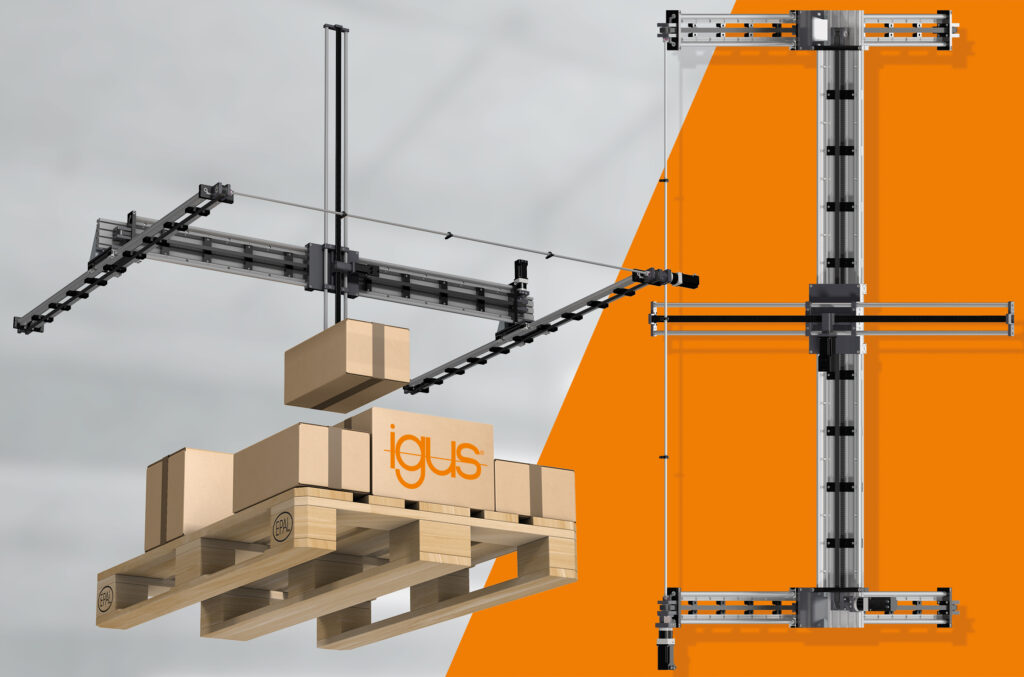Low-cost automation in XXL: Large DIY palletiser robot from igus at a low price
29/06/2022

The drylin XXL gantry robot is up to 60% cheaper than comparable robot solutions and is particularly easy to put into service, with free online configuration help.
Motion plastics specialist igus is expanding its low-cost automation range with a new drylin XXL room gantry robot. The robot has a working envelope of 2000 x 2000 x 1500mm and is particularly suitable for palletising applications up to 10kg. The robot is available from £8,000 including the control system and can be easily set up and programmed yourself without the help of a system integrator.
Too expensive to buy, too complex to program, too complicated to maintain: the reasons that many small and medium-sized companies shy away from automation investment, which can jeopardise their competitiveness in the long term. But getting started is very easy, a fact proven by the drylin XXL gantry robot from igus.
The DIY kit allows users to commission a pick-and-place linear robot quickly and easily for tasks including palletising, sorting, labelling and quality inspection.
“Palletising robots developed in cooperation with external service providers can cost between £80,000 and £120,000, more than the budget of many small companies,” says Adam Sanjurgo, Product manager of Low Cost Automation at igus UK. “We have therefore developed a much cheaper solution by using high-performance plastics and lightweight materials such as aluminium.” Depending on the type of stage, the drylin XXL room portal robot costs between £8,000 and £12,000, a low risk investment that usually pays for itself within a few weeks, Sanjurgo adds.
Do It Yourself: quick assembly with no previous robot knowledge
A buyer receives the room portal robot as a DIY kit. Key components are two timing belt axes and a rack and pinion axis with stepper motors for a working space of 2000 x 2000 x 1500mm. At the maximum, the robot can measure up to 6000 x 6000 x 1500mm. The package also includes a control cabinet, cables and energy chains as well as free control software, called igus Robot Control (iRC). Users can assemble the components into a ready-to-go linear robot in just a few hours, with no external help, without previous knowledge and without any formal training. And if additional components are needed, such as camera systems or grippers, users can quickly find what they need on the RBTX robotics marketplace.
Automation relieves employees
This Cartesian robot (a robot that moves in three linear axes, X, Y and Z) can be used, for example, on conveyor belts that transport products from injection moulding machines. In this case, the robot removes moulded parts with a maximum weight of 10kg from the production line, moves them at a speed of up to 500mm/s and positions them on a pallet with a repeatability of 0.8mm. “Thanks to this kind of automation, companies can relieve their employees of physically demanding and time-consuming palletising tasks and redeploy the resource for more important tasks,” says Sanjurgo.
The system does not require any maintenance: the linear axes are made of corrosion-free aluminium, the slides move over plain bearings made of high-performance plastic, which, thanks to integrated solid lubricants, enable low-friction dry running with no fluid lubricants for many years – even in dusty and dirty environments.
Digital 3D robot twin allows easy programming
Not only the assembly is easy, but also the programming of motion sequences. “For many companies that do not have their own IT specialists, robot programming is often fraught with problems,” says Sanjurgo. “That’s why we have developed the iRC, free software that resembles common office software and enables intuitive programming of the robot paths. The software is free and the resulting “low-code” programming can be used one-to-one on the real robot.” At the heart of the software is a digital twin of the room portal robot, which can be used to set movements with just a few simple clicks, even before the robot is installed and operating. “Before buying, potential users can use the 3D model to check whether their desired movements are actually feasible,” Sanjurgo says. “We invite anybody to try out our robots live or via the internet free of charge. We will support them during commissioning and show what is possible with low-cost robots, making the investment almost risk-free.”
